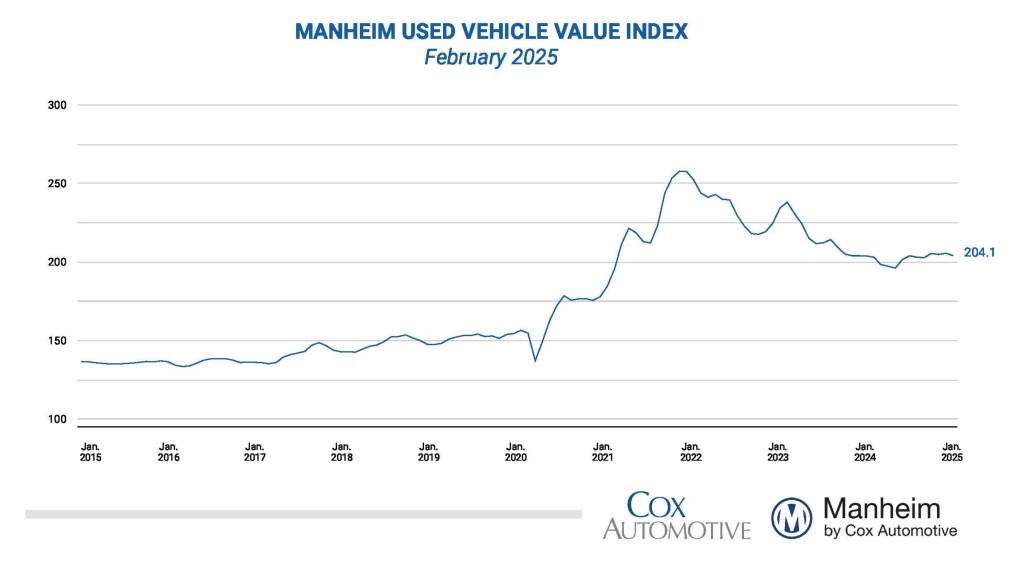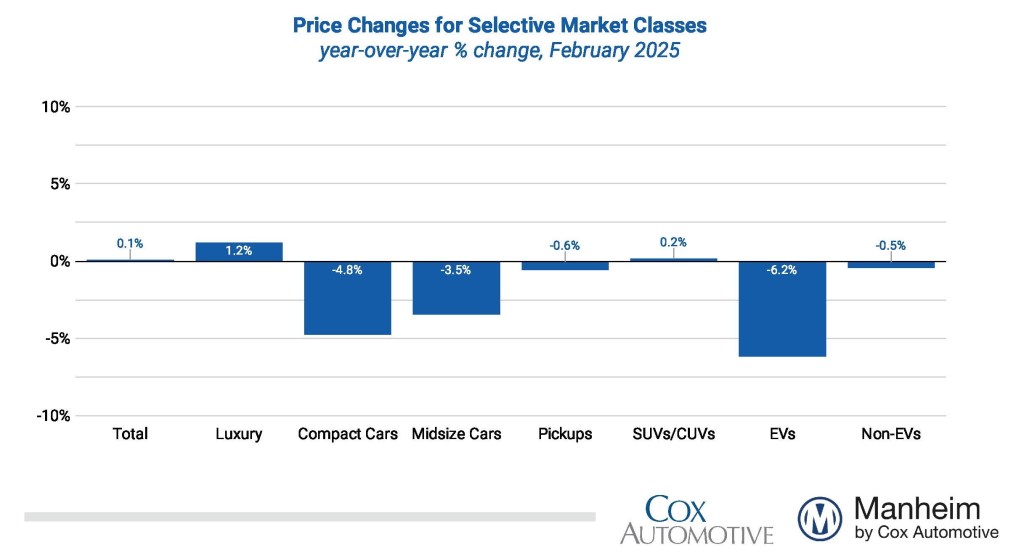Data Point
Wholesale Used-Vehicle Prices Decreased in February
Friday March 7, 2025
Wholesale used-vehicle prices (on a mix, mileage, and seasonally adjusted basis) were lower in February compared to January. The Manheim Used Vehicle Value Index (MUVVI) decreased to 204.1, which reflects a 0.1% increase from a year ago. The seasonal adjustment to the index drove the monthly move for the index, as non-seasonally adjusted values rose for the month. The non-adjusted price in February increased by 1.4% compared to January, moving the unadjusted average price up 0.8% year over year.

“With gray days and winter storms, it’s not uncommon to see some volatility in wholesale trends relative to long-term run rates in February, and that’s what we experienced over the course of the last four weeks,” said Jeremy Robb, senior director of Economic and Industry Insights at Cox Automotive. “Tax refund season drives the ‘spring bounce’ in wholesale markets, and it looks to have started off a bit slower this year, before ramping up at the end of February. The retail supply of used units is tighter than it was at this time last year, and tax refunds are motivating consumers to purchase used units, resulting in stronger dealer demand at Manheim in the last week of the month.”
In February, Manheim Market Report (MMR) values saw some volatility over the course of the month but ended with the last week of February seeing stronger price appreciation, with values rising 0.2% in the last week alone. Over the last four weeks, the Three-Year-Old Index increased an aggregate of 0.5%. Those same four weeks delivered an average increase of 0.2% between 2014 and 2019, indicating valuation trends were stronger than we usually experience at this time of year.
Over the month, daily MMR Retention, which is the average difference in price relative to the current MMR, averaged 99.0%, meaning market prices moved closer to MMR values this month and were higher against January levels. Compared to last year, valuation models were up by 1.1 percentage points (110 basis points) for MMR retention, which is one-tenth of a point higher than 2019 levels for the same period. The average daily sales conversion rate rose to 60.4%, an increase of 2.1 percentage points compared to last month and a little higher than normally seen at this time of year. For comparison, the daily sales conversion rate averaged 57.3% in February over the last three years.
Major market segments saw mixed trends for seasonally adjusted prices year over year in February. Compared to February 2024, the luxury segment rose the most, increasing by 1.2%, with SUVs also performing better than the industry, increasing 0.2% over the last year. Underperforming the industry, compact cars declined the most, falling by 4.8% against last year, mid-size sedans were down 3.5%, and trucks fell by just 0.6%. Compared to the previous month, the truck segment performed the best, moving higher by 0.2%, while luxury and SUVs were also better than the industry overall, falling by 0.5% and 0.7%, respectively. Faring worse than the industry overall, compact cars showed the largest decline, falling 1.6% over the last month, and mid-size sedans were down 1.1%.

Looking at the market by powertrain in February, electric vehicles (EVs) lost some of the monthly gains seen in the last couple of months, but they fell less against January than the industry overall. EV values were down 0.2% against January 2025, while non-EVs declined by 0.5% over the same time period. For February 2025, EV values are down 6.2% against February 2024, while non-EVs were lower by 0.5% year over year, which is a bit lower than the overall industry average.
Retail Used-Vehicle Sales Were Up in February
Assessing retail vehicle sales based on observed changes in units tracked by vAuto, initial estimates of retail used-vehicle sales in February were up 8.0% compared to January and higher year over year by 8.0%. The average retail listing price for a used vehicle decreased 0.6% over the last four weeks.
Using estimates of retail used days’ supply based on vAuto data, an initial assessment indicates February ended at 45 days’ supply, down three days from 48 days at the end of January and down five days from February 2024 at 50 days.
New-vehicle sales in February were down 0.7% from last year, yet volume increased 10.6% from a weaker January. The February sales pace, or seasonally adjusted annual rate (SAAR), came in at 16.0 million, up 0.3 million from last year’s pace and higher than the weaker 15.5 million level in January.
Combined sales into large rental, commercial, and government fleets decreased 12.3% year over year in February. Including an estimate for fleet deliveries into dealer and manufacturer channels, the remaining new retail sales were estimated to be up 3.9% from last year, leading to an estimated retail SAAR of 12.8 million, up 4.6% from last year’s pace, and also higher than January’s estimated 14.0 million level. Fleet share was estimated to be 18.4%, down from last year’s 22.0% share.
Rental Risk Price and Mileage Results Were Higher Against Last February
The average price for rental risk units sold at auction in February increased 1.9% year over year. Additionally, rental risk prices rose by 1.2% compared to January. Average mileage for rental risk units in February (at 55,300 miles) rose 15.6% for the month against last year’s level, the highest level for February readings since 2023. For the month of February, rental unit average mileage was 0.9% lower compared to January 2025.
Measures of Consumer Confidence Declined in February
The Conference Board Consumer Confidence Index® declined 6.6% in February, which was worse than the decline expected; but January’s index was revised higher. Consumers’ views of the present and the future declined, but views of the future declined the most. Consumer confidence was down 6.2% year over year. Plans to purchase a vehicle in the next six months declined modestly to the lowest level since last February, but plans to purchase were slightly higher year over year. The sentiment index from the University of Michigan declined 9% in February to 64.7, which was lower than expected and marked a larger decline than the earlier reading at the beginning of the month. With the final monthly decline, the index was down 15.9% year over year to the lowest level since November 2023. The underlying views of current conditions and future expectations declined, with current conditions falling the most. Expectations for inflation in one year increased to 4.3% from 3.3%, and expectations for inflation in five years increased to 3.5% from 3.2%. Consumers’ views of buying conditions for vehicles declined to the lowest level since August as views of prices deteriorated, but the views of interest rates were steady. The daily index of consumer sentiment from Morning Consult declined 1.7% in February, adding to the slight 0.1% decline in January. The index ended the month up 6.3% year over year. According to AAA, the national average price for a gallon of unleaded gas remained at $3.10, unchanged in February from the end of January but down 7% year over year.
For questions or to request data, please email manheim.data@coxautoinc.com. If you want updates about the Manheim Used Vehicle Value Index, as well as direct invitations to the quarterly call sent to you, please sign up for our Cox Automotive newsletter and select Manheim Used Vehicle Value Index quarterly calls.
Note: The Manheim Used Vehicle Value Index was adjusted to improve accuracy and consistency across the data set as of the January 2023 data release. The starting point for the MUVVI was adjusted from January 1995 to January 1997. The index was then recalculated with January 1997 = 100, whereas prior reports had 1995 as the baseline of 100. All monthly and yearly percent changes since January 2015 are identical. Learn more about the decision to rebase the index.
